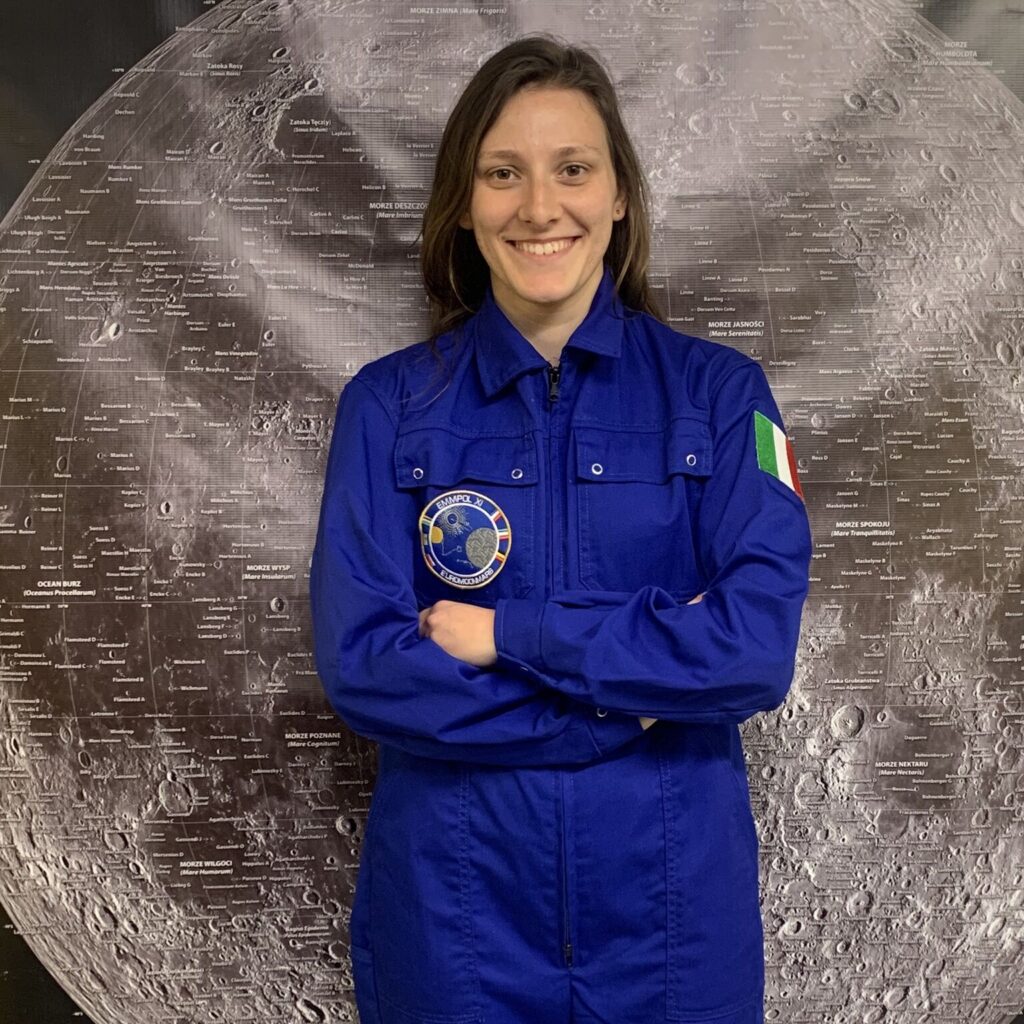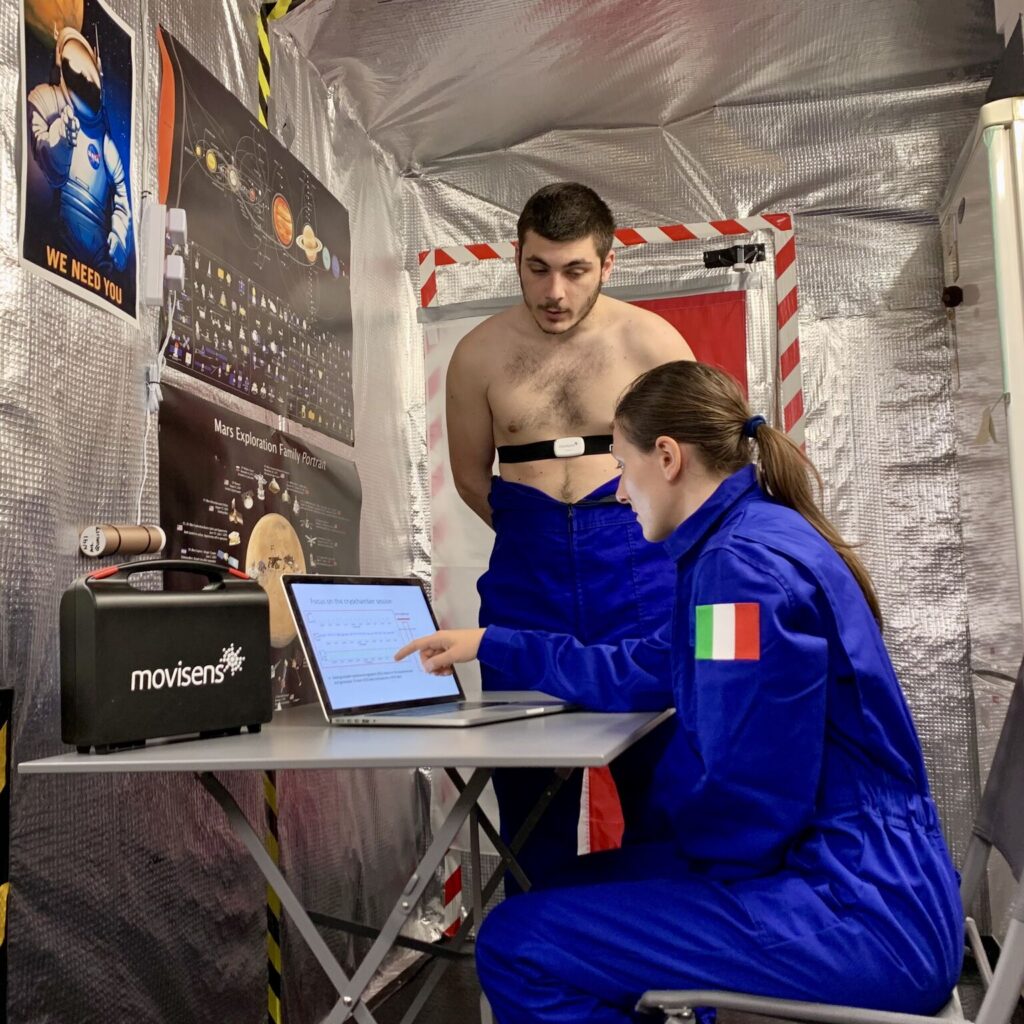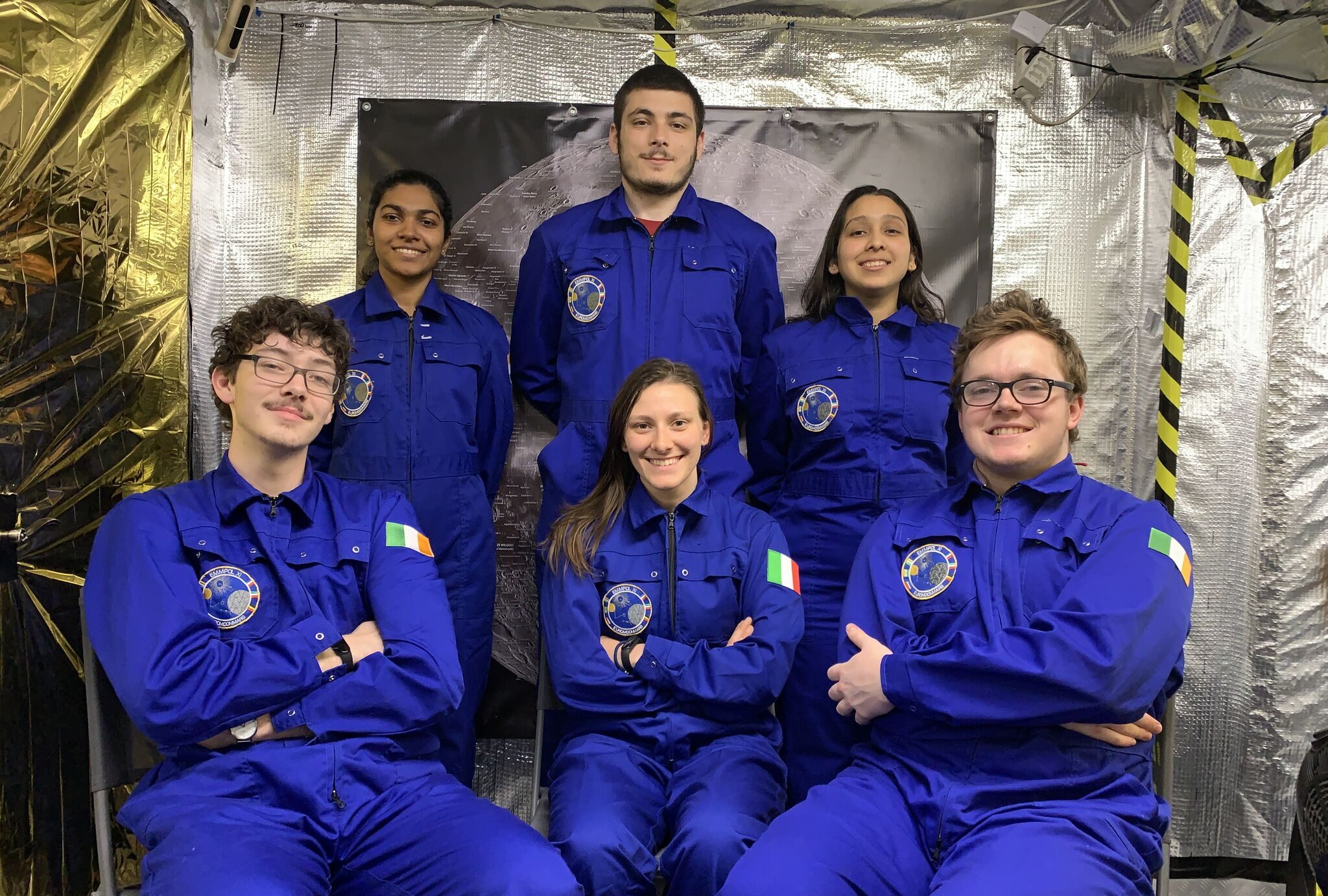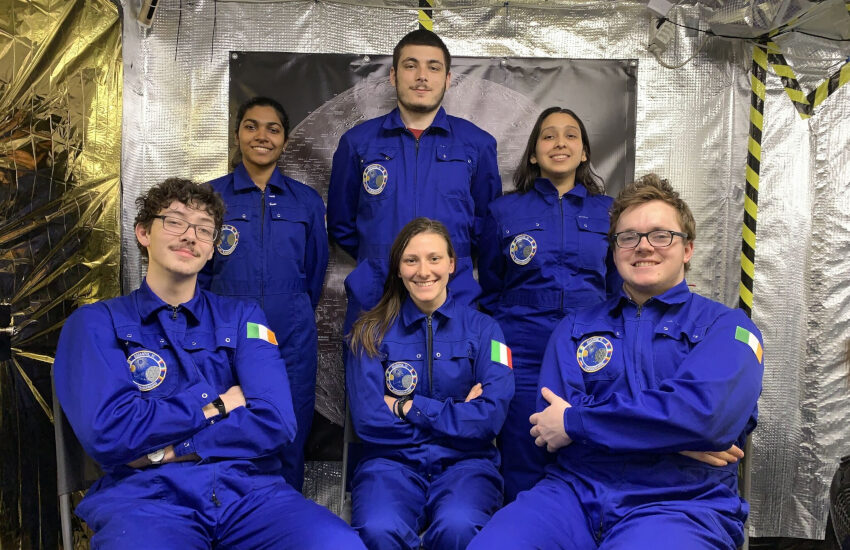The exploration and study of space has fascinated human beings since ancient times and technological progress has, in recent years, allowed mankind to achieve unimaginable results, such as the moon landing more than fifty years ago. How does one prepare for future space missions? Exactly the same as for sports competitions and theatre shows: rehearsing and rehearsing again, simulating the endeavour. Just like athletes and actors, scientists prepare for future exploration through simulations here on earth.
In the Kinosomno project, funded by the Italian Space Agency, Sara Solbiati, a researcher from Politecnico di Milano’s Department of Electronics, Information and Bioengineering (DEIB), participated in an experiment which simulated living in a lunar habitat, for the International Lunar Exploration Working Group (ILEWG) EuroMoonMars programme, through EMMPOL missions.
During their stay in a confined environment for 7 days, the team members conducted research activities for data analysis, tests and the development of equipment. The team members were isolated from natural light during their stay (like astronauts during space flight), with implications on their circadian metabolic cycles, immune system, sleep quality and performance.
Sarah Solbiati tells Frontiere about her journey and experience in the lunar habitat.
How did your passion for space come about?
“I started to become interested in space when I was doing my Laurea (equivalent to Bachelor of Science) and Laurea Magistrale (equivalent to Master of Science) degree theses in the area of research on space philosophy and the application of wearable devices for missions.
During my academic career I followed a course at the European Space Agency Academy on philosophy in space and after my laurea I continued to engage with the topic, initially with a research grant and now with a PhD funded by the Politecnico di Milano and the National Research Council, on Italian Space Agency projects”.

How did you become involved in this project?
“Beyond ‘classic’ research, I have always been interested in being involved personally in the study of the cosmos: the opportunity to experience a space mission simulation was a great moment for me. In April, I had the opportunity to participate in two missions simulating life in a lunar habitat called EMMPOL 10 and EMMPOL 11, where EMMPOL stands for EuroMoonMars Poland, because these missions are carried out thanks to a partnership between EuroMoonMars, an association that supports this type of study, and the Analog Astronaut Training Center in Krakow, Poland. Both missions lasted seven days. During the first one, I was remote mission control, so I helped the people staying in the habitat from the outside. In EMMPOL 11, I participated as a team member together with another 5 researchers and students of various nationalities and scientific backgrounds.
As a team, we were ‘analogue astronauts’, because we were testing an analogue simulation of living in space.
During both missions, I had the opportunity to advance my research and continuously monitor all team members for 7 days (11 subjects in total, divided into two separate groups, recording their electrocardigraphic (ECG, electrocardiac activity) and seismocardiographic (SCG, mechanical cardiac activity) signals, through innovative sensors offered by the company Movisens. Positioned in contact with the thorax, the devices detect the thorax movement produced by the heart beat. From this signal, it is possible to observe both heart rate and other important parameters for the heart’s mechanics”.
How did you prepare for the missions?
“I was contacted by the organisers to start planning this mission at the end of January. From then until the beginning of April, when the first campaign started, we met remotely every week to define and plan the mission well from all points of view: the technical, the organisational, the scientific…. We met for the first time on 8 April, in Krakow, the mission location, to start monitoring the first signals and teaching the team members how to use the device. I returned on 19 April for my mission. It was the first time that we met the other team members (the mission would start on the 21st). We had a day and a half of preparation and training. After all the Ethics Committee forms had been signed, the pre-training session was held on the first evening, and consisted of a brisk walk to the highest point in Krakow, in the dark and with no mobile phones. We could only use body language to communicate. It served to test how we behaved in a team and our physical fitness. Having had to keep silent and listen to all the sounds around us, once we arrived at the top we were asked how many aeroplanes had taken off, landed or passed overhead… and we all answered correctly: we had already adapted well to the situation.
The next day there was a group cryotherapy session, first at -60°C and then at -120°C. I managed to take recordings with the Movisens before and after the experiment.Cryotherapy is very important in space research, because it has the effect of reducing metabolism. If we consider long-term missions in the future, when limited provisions of water and food will necessarily need to be brought, it will be necessary to somehow slow one’s metabolism to consume fewer resources. It is interesting to look at how the cardiovascular system behaves in response to cryotherapy. It is a simulation on earth, to be more prepared what will need to be done during real missions. The second part of the training consisted of getting into a frozen lake (we managed to stay in for over twenty minutes).
The evening of 20 April, after having acquired our supplies for the week, we went inside the Storberg Habitat, in Rzepiennik, two and a half hours from Krakow, isolated in the forest.
After sorting out the supplies, we were trained on how to move around the various modules in the habitat, for scientific experiments or any other reason. Then the isolation officially began”.

What was the mission habitat like?
“The habitat was divided into modules. Biology experiments were conducted in the first one, at the entrance, called the Geolab. Then there was a bunker module, a small gym with cycling machines and treadmills, a room with a kitchen and the bedroom with six beds.
T o avoid the accumulation of CO2, we had to distribute ourselves among these rooms, which had no windows and consequently no natural light or air.In fact, as early as the first day our carbon dioxide levels got too high and we had to modify the ventilation system: that was the first challenge, solving a problem using only the resources present within the habitat.Gravity was the same as on earth but in the EMMPOL 10 mission there was a small machine for reproducing microgravity with biological samples inside”.
What was your typical day like?
“Our research was investigating the psycho-social aspect and changes to circadian rhythms during space missions. Our day was very dense, based on all the activities that we had to do, and punctuated by a timetable that started with the wake-up T0 and every subsequent hour being T0+1, T0+2, and so on.
On the electronic devices, we had to set a time zone decided by the external control centre. For example, we started with Chennai, India, and then after two days we switched to the time zone of Oakland, New Zealand.
The system was very important for measuring the subjective perception of time: by the second day, our days were no longer punctuated by morning, lunch, afternoon, dinner, sleep, but by T0+X and the planned activities… Our circadian rhythms were very stressed: the days were very intense, we had so many experiments to do; mine with the Movisens device but also the others, who conducted studies ranging from physiology to biology, from psychology to engineering and robotics…
On waking up, we had to do an hour of medical tests: we measured our temperature, blood pressure and heart rate, weight, urine examination (every other day) and sleep quality, and we took an online test for our subjective perception of time. This consisted of clicking on the monitor every 5 seconds.
Then there was breakfast with a briefing.Our team was made up of six members, each with their own role: captain, vice-captain, medical officer (responsible for obtaining physiological parameters), space engineer, public outreach officer (responsible for communication with the general public)… I had the role of Communication Officer: I had to give the control centre a summary of how we had spent the day and night. What’s more, I also reported the day’s agenda and any problems to the control centre, maintaining continuous communication with the control centre in case of emergency. After the morning briefing, we started the experiments.
We had one hour of exercise a day and the exercise session involved measuring physiological parameters such as heart rate, blood pressure, but also time perception.
Later in the day was the ‘Da Vinci power nap’, a regenerative nap inspired by the ones taken by Leonardo, on an elastic cloth attached to the ceiling as if it were a hammock. Someone on the outside would give it a swing and you were in there for 10 or 20 minutes with the lights out… everyone would fall asleep (it was really relaxing!). My colleagues were studying it to assess its positive effects on the cardiovascular system (which I was monitoring with Movisens) and on cognitive performance. This activity was also followed by physiological tests, a time perception test and the performance of a sudoku to measure our concentration levels.
After lunch, the afternoon was characterised by experiments or exercise (for those who hadn’t done it in the morning).After dinner there was another series of experiments and physiological tests, one of which involved kombucha (fermented tea).At lunch, we would drink 100 ml of it and after dinner three of us would put on a mask made of this tea (the other three would use another cream): we measured skin parameters before and after application to see its effects.
Throughout the day, every two hours we would perform circadian measurements and then measure our body temperature, weight and mood, the latter by completing questionnaires.
In the evenings we would also conduct a virtual reality experiment to understand whether it induces stress or relaxation. I am collaborating with the author of this study to supplement the subjective measurement with an objective measurement using Movisens”.
What would the subject perceive in the virtual reality?
“For this virtual reality experiment there were three control subjects, who did not wear the headset, and three people who did participate in the experiment, and I was one of the latter. The tests, which lasted 10-15 minutes, were conducted every evening with various scenarios, always linked to space: International Space Station navigation, the lunar landscape… After the experience, we had to complete a mood barometer – a scale for measuring mood. We also spend the last three days completing socio-psychological questionnaires received from outside, related to how we perceived the team and the captain.
What types of experiment did you conduct?
“The experiments were very varied: bacteria cultures, friction tests on a rover involving various materials (powders that reproduce the surface of a comet or the moon), or even the cultivation of plants and urine analysis using spectroscopy (pre- and post-breakfast and in the evening) to look for stress indicators.
One experiment involved the collection of various types of tear: control tears (where we would put distilled water in our eye and then collect it from the other side), tears of happiness, sadness, irritation (simply using an onion). The data collected will be analysed by another research institution.
Another experiment was the polarised light test in which we had to look at an image on a monitor and then describe what we were seeing to understand whether or not the polarised light was being perceived.
Another test involved wearing a small movement sensor on the spine to analyse the subject’s posture, and develop a method of recognising prolonged bad posture. In fact, in the absence of gravity, astronauts often work in unusual postures, with possible negative effects over time.
During the mission, we performed several activities involving the public, including a streaming event on YouTube in which we spoke about our activities inside the habitat”.
How was it working in your mission team?
“The team was an important aspect for the mission. The simulation analysis did not only look at physiological aspects, but psychological aspects too: it was fundamental to analyse the behaviour of a group of people forced to live together in the same environment for a prolonged period of time, isolated, confined from the rest of the world, with no communication with loved ones. This also influences perception of what there is outside, without the whole flow of news to which we are subject every day.
On the last day, we performed an emergency simulation and, following the standard protocols, we pretended we had been hit by a meteor shower. We constantly received information on the procedures to follow from the control centre, and teamwork was essential. It was a very collaborative and productive team that was able to work calmly”.
Do you have any activities planned for the near future?
“After my mission, I remained in contact with the organisers and we presented the data gathered at two international events: the Committee on Space Research (COSPAR) Assembly and the International Astronautical Congress. There will be publications in scientific magazine and conference publications.
My analyses form part of a research project financed by the Italian Space Agency on the use of wearable devices to monitor physiological parameters in space. In the future I will concentrate both on the study of changes in circadian rhythms detected during the missions and electrical and mechanical cardiac activity. I will also assess the evolution of cardiac variability over the 7 days of isolation to obtain a bio-marker correlated to stress, and it will be interesting to see the effects of the ‘Da Vinci power nap’ on the cardiocirculatory system. It will be stimulating to analyse the effects of the pre-training cryotherapy on the cardiovascular system. Moreover, I will collaborate on the project that used virtual reality headsets to the examine stress or relaxation induced by the experiment”.

Intuitions and technologies emerging from the space sector frequently also find uses in civil contexts. Could these data also potentially be used in everyday life?
“Movisens is a comfortable, light device that can be work by anyone without too much hassle: it can contribute to the monitoring of cardiovascular parameters in subjects on the ground too. These data (of which there is a lot, on 15 subjects over 7 continuous days) will be used to create automatic learning algorithms capable of recognising biomarkers, constant characteristics, related to cardiovascular activity and cardiac mechanics in particular, opening the way for new applications.
This type of research is very innovative because we are discovering more and more about the importance of circadian rhythms and the day-night rhythm. We know that isolation or working different hours during the week, not following normal cycles of light and dark, cause changes to circadian rhythms that favour the onset of a number of chronic diseases.
What’s more, the various physiological parameters that were measured can also be analysed from the metabolic point of view”.
What have you taken home from this experience? What is your personal balance?
This experience helped me to grow from a psychological point of view, in my relationship with myself, others and the world, and also in terms of work, because I am much more focussed and aware of what I need to do to achieve certain goals.
One interesting thing that happened during my mission: to cover the noise of the ventilation a little and to give rhythm to the days, we always had background music on.On the fourth day we all felt the need to lower the volume a little, including when talking and during my exercise session, in the break between one exercise and another, and a helicopter flew over the habitat. At that moment, we asked ourselves what we missed from the outside world.During lockdown, we were physically isolated but still connected to the rest of the world; here we were not. This led me to a greater awareness of and connection to the earth”.
What are your long-term plans?
“I would certainly like to participate in another simulation campaign because it brings me one step closer to fulfilling a dream: to become an astronaut! There were selections this year, but unfortunately I did not have the required working experience of at least three years. However, through simulations like this one I am preparing for future selections.”

